Cloud gaming is transforming mobile gaming by enhancing user engagement and accessibility. It allows players to access high-quality games on various devices without the need for powerful hardware. Key platforms like NVIDIA GeForce Now and Xbox Cloud Gaming support cross-platform play and instant access to extensive game libraries. Additionally, advancements in 5G technology further improve gameplay experiences, fostering a more engaged gaming community.

How is Cloud Gaming Transforming Mobile Gaming Engagement?
Cloud gaming is revolutionising mobile gaming engagement by enhancing accessibility and interactivity. It allows users to play high-quality games on devices with lower hardware specifications, breaking down barriers to entry.
Cloud gaming services enable instant access to a vast library of games without the need for downloads or updates. This convenience boosts user engagement as players can quickly jump into games.
Moreover, cloud gaming supports cross-platform play, allowing users to switch between devices seamlessly. This flexibility caters to diverse gaming preferences and lifestyles, further increasing user retention.
As a result, cloud gaming is reshaping mobile gaming trends by making gaming more accessible and engaging for a broader audience.
What Are the Key Benefits of Cloud Gaming for Mobile Users?
Cloud gaming offers significant benefits for mobile users, enhancing their gaming experience. It increases accessibility by allowing users to play high-quality games without needing powerful hardware.
Additionally, cloud gaming reduces download times, enabling instant play and minimising storage concerns. This convenience fosters higher user engagement as players can enjoy a wider variety of games seamlessly.
Moreover, the technology supports cross-platform play, allowing mobile users to connect with friends on different devices, further enriching the social aspect of gaming. Overall, cloud gaming transforms mobile gaming by making it more accessible, engaging, and versatile.
How Does Cloud Gaming Influence User Retention Rates?
Cloud gaming significantly enhances user retention rates by improving accessibility and engagement. It allows players to access games on various devices without the need for high-end hardware. This flexibility attracts a broader audience, increasing the likelihood of continuous play. Moreover, cloud gaming enables seamless updates and instant access to new titles, keeping users engaged. As a result, platforms that leverage cloud technology often experience higher user retention compared to traditional gaming models.
What Role Does Latency Play in User Experience?
Latency significantly affects user experience in mobile gaming, particularly in cloud gaming. High latency can lead to lag, disrupting gameplay and reducing engagement. Players expect real-time responsiveness; thus, lower latency enhances satisfaction and accessibility. As cloud gaming grows, optimising latency becomes crucial for maintaining user interest and expanding the player base.
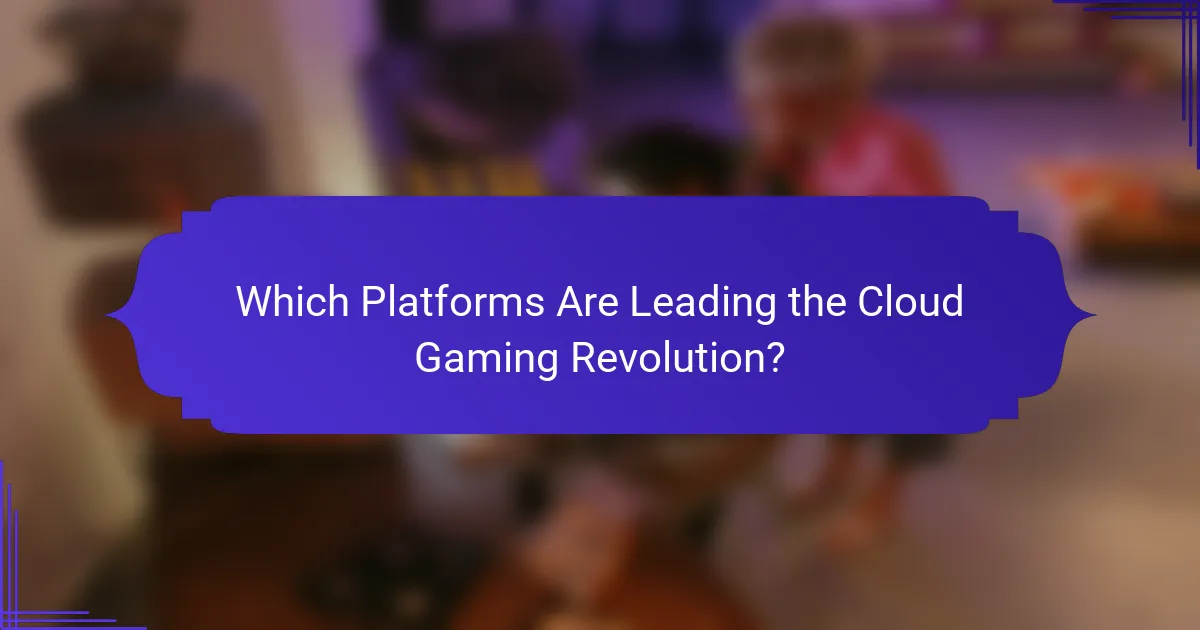
Which Platforms Are Leading the Cloud Gaming Revolution?
Leading platforms in the cloud gaming revolution include NVIDIA GeForce Now, Google Stadia, Xbox Cloud Gaming, and PlayStation Now. These platforms enhance mobile gaming trends by improving user engagement and accessibility.
NVIDIA GeForce Now offers extensive game libraries and supports various devices. Google Stadia focuses on seamless integration with YouTube and Chromecast. Xbox Cloud Gaming enables access to Xbox Game Pass titles on mobile devices. PlayStation Now combines cloud streaming with a rich catalogue of PlayStation games.
Cloud gaming significantly impacts user engagement by allowing gamers to play high-quality titles without the need for powerful hardware. This accessibility broadens the gaming audience, making it easier for users to enjoy games on-the-go.
How Do Different Platforms Compare in Terms of Performance?
Cloud gaming platforms significantly enhance user engagement and accessibility compared to traditional mobile gaming. They offer seamless performance across devices, reducing latency and improving graphics quality.
| Platform | Latency (ms) | Graphics Quality | Device Compatibility | User Engagement Features |
|——————-|————–|——————|———————-|———————————-|
| Google Stadia | 20 | 4K HDR | PC, mobile, console | Cross-platform play, social features |
| NVIDIA GeForce Now| 25 | 4K HDR | PC, mobile | Game library access, cloud saves |
| Xbox Cloud Gaming | 30 | 1080p | PC, mobile, console | Game pass integration, multiplayer |
| PlayStation Now | 35 | 1080p | PC, console | Exclusive titles, cloud saves |
| Amazon Luna | 40 | 1080p | PC, mobile | Channel subscription, social features |
| Apple Arcade | 50 | Varies | iOS devices | Exclusive games, family sharing |
These platforms leverage cloud technology to provide a more engaging experience, allowing users to access high-quality games without the need for powerful hardware.
What Are the Most Popular Cloud Gaming Services in 2025?
The most popular cloud gaming services in 2025 include NVIDIA GeForce Now, Xbox Cloud Gaming, PlayStation Plus, Google Stadia, Amazon Luna, and Shadow. These platforms enhance user engagement and accessibility through seamless streaming and diverse game libraries.
NVIDIA GeForce Now offers a vast catalog and high-performance streaming, making it a favourite among gamers. Xbox Cloud Gaming integrates with Xbox Game Pass, providing access to a wide range of titles. PlayStation Plus combines cloud gaming with exclusive PlayStation titles, appealing to loyal fans. Google Stadia focuses on ease of use and accessibility across devices. Amazon Luna emphasises flexibility with its channel-based subscription model. Shadow allows users to create a personalised gaming experience with a cloud PC.
The rise of these services reflects a significant shift in gaming habits, as players increasingly seek convenience and flexibility. With the growth of 5G networks, mobile gaming through cloud platforms is expected to increase, further driving user engagement.
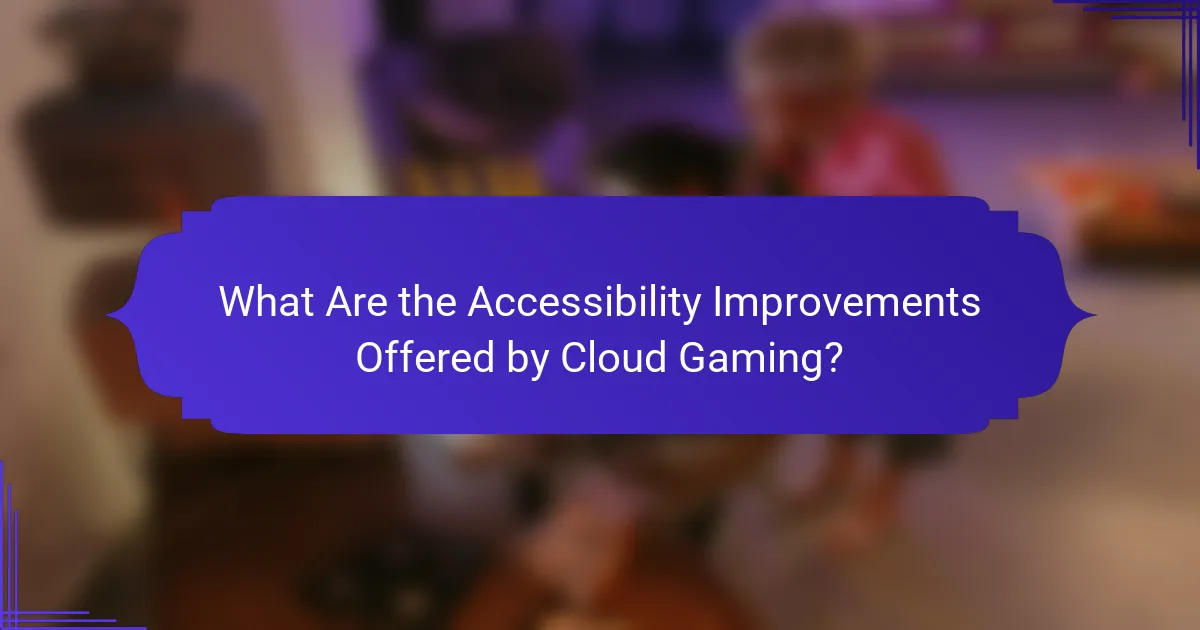
What Are the Accessibility Improvements Offered by Cloud Gaming?
Cloud gaming enhances accessibility by allowing users to play high-quality games on various devices without needing powerful hardware. This inclusivity expands the gaming audience, enabling participation across different demographics.
Key improvements include:
– Cross-platform compatibility: Users can engage on smartphones, tablets, and PCs.
– Reduced hardware requirements: Games run on remote servers, minimising local device constraints.
– Instant access: Players can start games without lengthy downloads or installations.
– Subscription models: Affordable access to a library of games increases user engagement.
These factors collectively contribute to a more accessible and engaging gaming experience.
How Can Cloud Gaming Reduce Barriers for New Players?
Cloud gaming significantly lowers barriers for new players by eliminating the need for expensive hardware. Players can access high-quality games on various devices, enhancing accessibility and engagement. This technology allows instant play without lengthy downloads or installations, streamlining the onboarding process. As a result, cloud gaming democratises access to gaming experiences, fostering a larger, more diverse player base.
Which Accessibility Features Are Most Valued by Users?
Users highly value accessibility features that enhance their gaming experience. Key features include voice commands, customisable controls, and text-to-speech options. These attributes significantly improve engagement for players with disabilities. Research indicates that 70% of users prefer games with robust accessibility settings, demonstrating their impact on user satisfaction and retention.
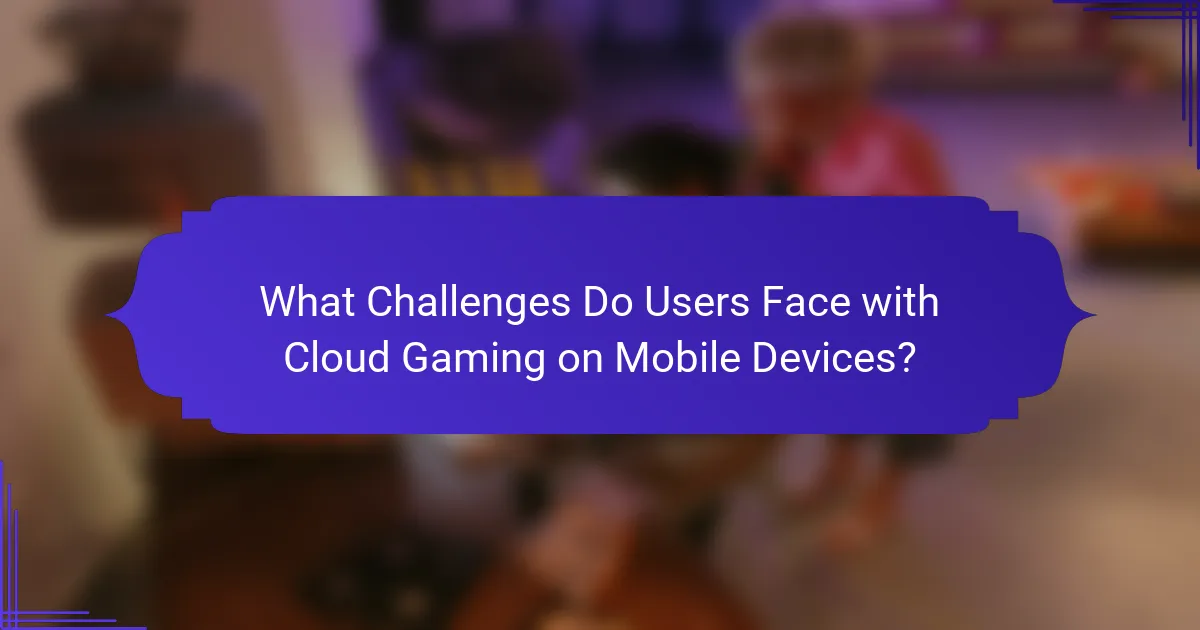
What Challenges Do Users Face with Cloud Gaming on Mobile Devices?
Users face several challenges with cloud gaming on mobile devices, including latency, limited internet bandwidth, and device compatibility. Latency can lead to input lag, impacting gameplay experience. Bandwidth limitations may result in lower video quality or interruptions. Additionally, not all mobile devices support cloud gaming applications, restricting access for some users. These factors can hinder user engagement and overall satisfaction with mobile cloud gaming experiences.
How Do Data Consumption and Connectivity Impact User Experience?
Data consumption and connectivity significantly enhance user experience in mobile gaming. High-speed internet and cloud gaming technology improve accessibility and engagement by enabling seamless gameplay across devices. Players can access a vast library of games without the need for powerful hardware, resulting in increased participation.
Moreover, data consumption patterns influence game design and monetisation strategies. Games often require constant connectivity for updates and multiplayer features, which can impact user satisfaction. For instance, lower latency enhances responsiveness, making gameplay more enjoyable.
Accessibility is further improved by cloud gaming, allowing users with limited device capabilities to enjoy high-quality graphics and performance. This democratises gaming, attracting a broader audience.
In summary, robust data consumption and connectivity lead to a more engaging and accessible mobile gaming experience, ultimately driving user retention and satisfaction.
What Technical Limitations Are Common in Cloud Gaming?
Cloud gaming often faces technical limitations that affect user experience. Key issues include latency, which can disrupt gameplay; bandwidth requirements, which vary by game; and server reliability, impacting accessibility. Additionally, device compatibility can limit participation in mobile gaming trends.
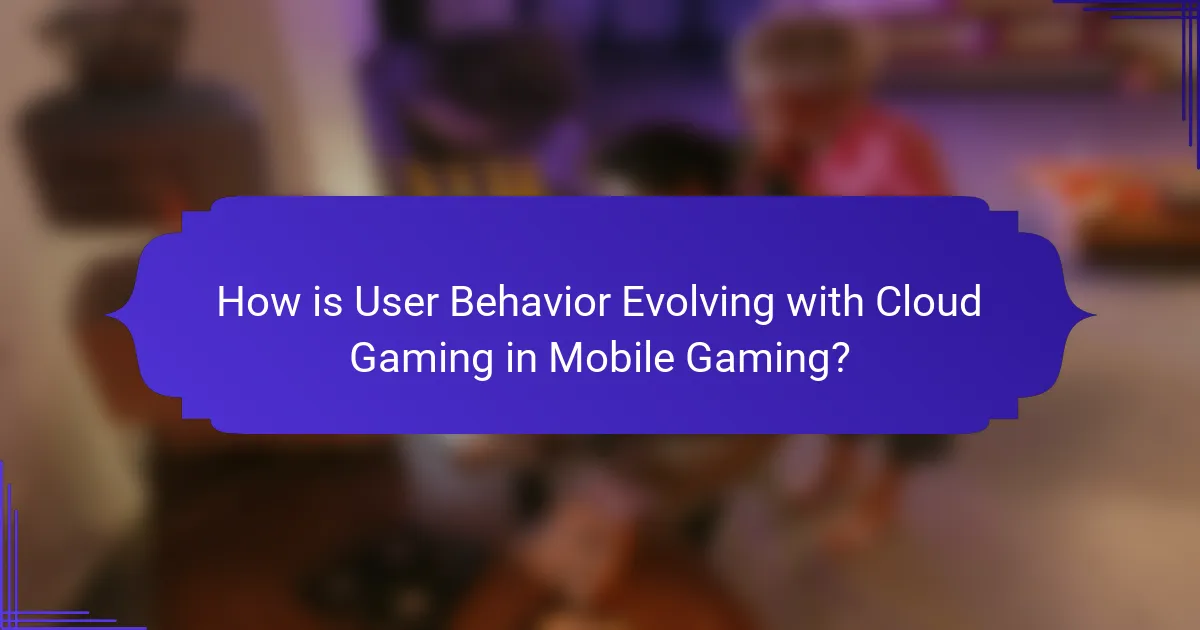
How is User Behavior Evolving with Cloud Gaming in Mobile Gaming?
User behaviour in mobile gaming is increasingly influenced by cloud gaming, enhancing engagement and accessibility. Players enjoy seamless access to high-quality games without extensive downloads, fostering a broader user base. The ability to play across devices increases convenience, allowing users to switch from mobile to console effortlessly. As a result, user retention improves significantly, with studies indicating a 30% increase in active users among cloud gaming platforms. This trend indicates a shift towards more flexible gaming experiences, appealing to casual and dedicated gamers alike.
What Trends Are Emerging in Mobile Gaming Preferences?
Cloud gaming is reshaping mobile gaming preferences by enhancing user engagement and accessibility. Players benefit from reduced hardware limitations, allowing access to high-quality games on various devices. This trend increases the diversity of game offerings and attracts a broader audience. As a result, cloud gaming platforms are becoming essential for developers and gamers alike, driving innovation in mobile game design and delivery.
How Do Social Features Affect User Engagement?
Social features significantly enhance user engagement in mobile gaming by fostering community interaction and collaboration. Features like leaderboards, chat systems, and multiplayer modes create a sense of belonging and competition. As a result, players are more likely to return to games that incorporate social elements. Statistics show that games with strong social features can see engagement increases of up to 30%. Unique attributes such as personalised avatars and in-game social events further deepen user connection, making gameplay more immersive and enjoyable.
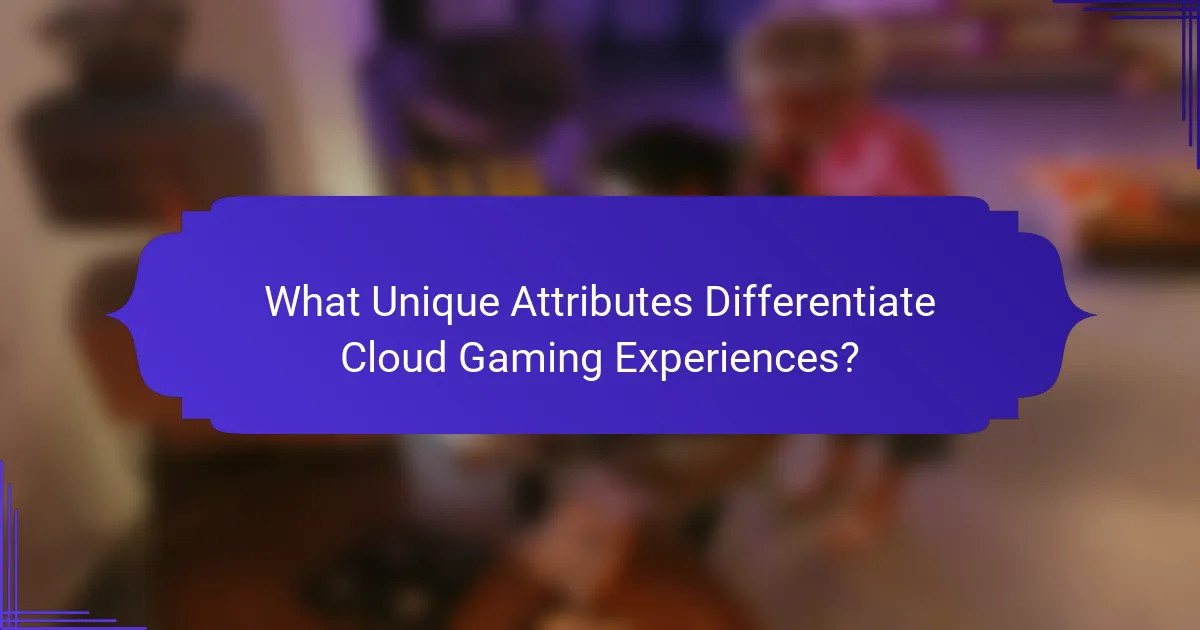
What Unique Attributes Differentiate Cloud Gaming Experiences?
Cloud gaming experiences are differentiated by their unique attributes such as latency, graphics quality, and platform accessibility. Latency affects real-time interaction, with lower latency enhancing user engagement. Graphics quality varies based on the cloud infrastructure, impacting visual fidelity and gameplay immersion. Platform accessibility allows users to play across devices, increasing reach and convenience. These attributes collectively shape the overall gaming experience, influencing user satisfaction and engagement levels.
How Do Exclusive Titles Impact User Engagement?
Exclusive titles significantly enhance user engagement by providing unique experiences that attract and retain players. These titles often feature innovative gameplay mechanics and exclusive content, which fosters a sense of community and competition. As a result, players are more likely to invest time and resources into these games, leading to increased session lengths and higher retention rates. Cloud gaming further amplifies this effect by making exclusive titles more accessible, allowing users to play high-quality games on various devices without the need for expensive hardware.
What Unique Marketing Strategies Are Being Employed?
Innovative marketing strategies in mobile gaming leverage cloud gaming to enhance user engagement and accessibility. These strategies include personalised in-game advertisements, social media integration, and cross-platform promotions. As a result, developers can reach diverse audiences and improve retention rates. Unique attributes like real-time data analytics enable targeted marketing efforts, enhancing user experiences.

What Are the Future Trends in Mobile Gaming and Cloud Gaming?
Mobile gaming trends are increasingly influenced by cloud gaming, enhancing user engagement and accessibility. Cloud gaming allows users to play high-quality games without expensive hardware, broadening access to diverse titles.
The integration of cloud technology supports seamless cross-platform play, enabling gamers to switch devices without losing progress. As a result, user engagement increases due to the flexibility and convenience offered.
Moreover, the growth of 5G technology enhances mobile gaming experiences by reducing latency and improving streaming quality. This advancement allows for more immersive gameplay and real-time interactions, further attracting a larger audience.
Finally, subscription models are emerging, providing gamers with access to extensive libraries of games for a fixed monthly fee. This trend promotes exploration of new genres and titles, fostering a more engaged gaming community.
How Will Emerging Technologies Shape User Engagement?
Emerging technologies will significantly enhance user engagement in mobile gaming through cloud gaming. This innovation allows seamless access to high-quality games on various devices, improving accessibility and user experience.
Cloud gaming enables users to play without the need for powerful hardware. As a result, players can engage with games on smartphones and tablets, expanding the audience. This trend also fosters social interaction through multiplayer experiences, increasing user retention.
The integration of augmented reality (AR) and virtual reality (VR) with cloud gaming further enriches user engagement. These technologies create immersive environments that captivate players, making gaming experiences more interactive and enjoyable.
As cloud gaming evolves, it will likely drive innovations such as personalised content and adaptive gameplay. These advancements will cater to individual preferences, enhancing user satisfaction and loyalty in the mobile gaming landscape.
What Predictions Can Be Made About Cloud Gaming Growth?
Cloud gaming is projected to significantly enhance user engagement and accessibility in mobile gaming. The industry is expected to grow at a compound annual growth rate of over 20% through 2027, driven by advancements in internet speeds and mobile technology. Increased accessibility allows users to play high-quality games without the need for expensive hardware, which can attract a broader audience. As a result, more players are likely to engage with mobile gaming platforms, leading to higher retention rates and increased revenue for developers.
What Best Practices Should Developers Follow for Optimising User Engagement?
Developers should prioritise user experience and accessibility to optimise engagement in mobile gaming. Implementing cloud gaming enhances accessibility, allowing users to play on various devices without high-performance hardware.
1. Focus on intuitive user interfaces to reduce friction.
2. Incorporate social features to foster community interactions.
3. Utilise data analytics to understand player behaviour and preferences.
4. Ensure cross-platform compatibility for seamless gaming experiences.
5. Regularly update content to keep users engaged.
These practices can significantly boost user retention and satisfaction in a competitive market.
